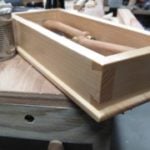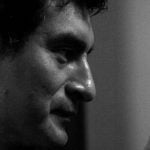why i cant plane this piece of oak ?
Welcome! / Forums / General Woodworking Discussions / Wood and Wood Preparation / why i cant plane this piece of oak ?
- This topic has 14 replies, 13 voices, and was last updated 3 years, 9 months ago by
Stewart Perry.
-
AuthorPosts
-
 26 April 2020 at 8:54 pm #658800
26 April 2020 at 8:54 pm #658800Could be a few things ……planing against the grain? Too much set? I assume your blade is sharp……what exactly is going on when you attempt to plane?
26 April 2020 at 9:05 pm #658805yes the blade is sharp ,and i plane with grain .
when i set the blade too high it doesnt cut nothing .
when i set it to the surface it stuck , by the way when i try to plane pine it works perfectly .
Thanks26 April 2020 at 9:57 pm #658813What angle do you sharpen with and how do you know you are really sharp? Sorry about the questions in case they sound too basic, but I used to struggle thinking I was sharp when I wasn’t. My biggest challenge was some recycled wenge flooring boards so far. Nasty, but a great lesson. Made me reconsider my sharpening technique, for planes and scrapers.
Paul has some blog entries that mention that at one point it just “clicks” what sharp really is. You start to see that everything else before was really not sharp.
27 April 2020 at 9:31 am #658864Looks like it’s got finish on it. This makes the surface extra hard … if so maybe better to cabinet scrape off, or sand with 80 grit, first.
Otherwise you could try Pauls plane refurb video on youtube. Various issues like sole and frog flatness (and blade back flatness) can lead to issues where you get no shaving until set aggressively then you get tearout.
Also worth considering (with a straightedge) the flatness of the board you ate planing. You’d expect no shaving on the low spots, that’s actually how a plane flattens boards 😉
 27 April 2020 at 1:58 pm #658881
27 April 2020 at 1:58 pm #658881Hej Sagi,
My humble contribution to answering your question is that it might be the properties of the oak that is holding you back.
[attachment file=”658882″]
The two pieces of oak on one of the attached photos, I think illustrates the issue. The faces of this heartwood cut the grain “tangentially”, which exposes a lot of latewood, which in itself puts up a lot of resistance, further enhanced by the crystallised extractives of the heartwood. [According to the expertise at my local timberyard, the main advantage of quartersawn wood is that the tangential aspect of the cut ends up on the long edge (doesn’t apply to quadratic cross sections, of course)].
My approach is to begin the planing with perpendicular strokes, then diagonal ones, and finally along the grain – with scant hope of anything but the thinnest shavings. A lengthy process, frequently interrupted for sharpening.
Good luck
Attachments:
You must be logged in to view attached files. 27 April 2020 at 1:59 pm #658886
27 April 2020 at 1:59 pm #658886Hej Sagi,
My humble contribution to answering your question is that it might be the properties of the oak that is holding you back.
[attachment file=”658887″]
The two pieces of oak on one of the attached photos, I think illustrates the issue. The faces of this heartwood cut the grain “tangentially”, which exposes a lot of latewood, which in itself puts up a lot of resistance, further enhanced by the crystallised extractives of the heartwood. [According to the expertise at my local timberyard, the main advantage of quartersawn wood is that the tangential aspect of the cut ends up on the long edge (doesn’t apply to quadratic cross sections, of course)].
My approach is to begin the planing with perpendicular strokes, then diagonal ones, and finally along the grain – with scant hope of anything but the thinnest shavings. A lengthy process, frequently interrupted for sharpening.
Good luck
Attachments:
You must be logged in to view attached files.27 April 2020 at 9:46 pm #658944It looks like a flat sawn piece and the full width of the log. You have several cathedrals, lots of reversing grain, particularly down the center of the board. You’ve tried a light set with a very sharp blade. Sometime a board just can’t be planed. Try a card scraper and/or a cabinet scraper, that should do the trick.
I didn’t believe this tip until I tried it. The thickness of the shaving is limited by how far back the cap iron is from the edge of the plane iron. The plane edge can only dig in as far as the cap iron allows it to. Especially for planing across the grain, make sure the cap iron is set back at least 3-4 mm from the edge of the iron.
And as Sven-Olof Jansson suggests, first plane across the grain and then diagonally across the grain. Use a jack plane with heavy set, or a scrub plane. You can get a slab such as in your photo very close to flat surprisingly quickly that way. Then your planing along the grain is smoothing (taking out the ridges from the passes across the grain) rather than flattening.
 17 May 2020 at 5:24 am #661696
17 May 2020 at 5:24 am #661696you have a micro camber on your blade instead of a macro-camber. the cutting edge is not meeting the wood properly. Even if it’s sharp, there is likely a bit of a lump right behind the edge. try grinding the cutting edge as flat as possible.
I had this issue a lot when i started planing. when your edge geometry is right, it will handle most grain well.
 8 June 2020 at 5:15 pm #664639
8 June 2020 at 5:15 pm #664639Sagi,
If your board is not flat, then you may experience the effect of not cutting until you extend the blade too much.
Also, the bevel of the blade should be around 25 – 30 degrees. If the bevel is too steep, then the cutting edge may not engage the wood and the plane is riding on the bevel belly over the wood.
 30 June 2020 at 2:36 am #667503
30 June 2020 at 2:36 am #667503I recently had a similar problem with a piece of a wood called cumaru, wich is extremely hard. The main problem wasn´t that the plane didn´t cut: it was the MASSIVE amount of reverse grain and tear out I had to deal with. In an area of 0.5m of wood, I oftenly had to change the direction of planing, even with my planes cutting really well.
The solution came from my father in law.He suggested me to use a tooth planed iron. Have you ever tried it? After several passes with it, using my planes on the wood was like cutting butter with a hot knife. It´s true that you spend more time by doing this, but it´s worth it. Also I keep the cap iron as close as possible to the iron (1mm may be) and as mentioned in other reply here, I would try to plane in many directions: diagonal, etc, to achieve the final result.
Hope you have fun and resolve the issue!
Attachments:
You must be logged in to view attached files.10 July 2020 at 4:54 pm #669085I believe the most likely issues are that either the board is convex along its length (in which case the plane will only bite at the ends) or the plane iron has a bevel that is too steep. If you sharpen by hand, or even if you are not careful when using a strop, it is possible to change the angle right at the tip of the blade to beyond 45 degrees, after which the tip will no longer meet the flat surface of the wood. The plane will still work in pine as the blade can bite into the soft surface by a fraction of a mm, but it will fail on harder woods. If this is the case you can restore the bevel to 25 degrees using a honing guide or similar, and then evaluate your sharpening technique to figure out what is causing the angle to steepen.
Hope you manage to resolve it one way or the other.
-
AuthorPosts
- You must be logged in to reply to this topic.
